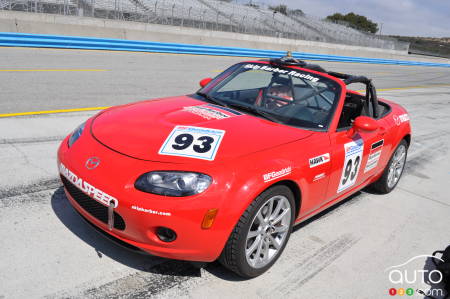Because it would be cruel not to give your Miata (your MX-5) the opportunity to be all it can be.
The Mazda MX-5 Miata was conceived for driving and being driven. Everything about the car was designed with the driver and his or her wishes in mind: these wishes being pure and clean sporty driving with minimal compromises comfort-wise.
Mazda put an enormous amount of effort into the drive when the car was first envisioned. In fact, so good are some of its mechanical elements that the majority remain almost untouched today in the next generation ND MX-5.
One such aspect is how the transmission and differential are mounted to each other allowing for soft mounts to deal with vibrations. The "trellis" link that connects the two also prevents the rear differential from shooting up under throttle tip-in, avoiding driveline shock and harshness. It also allows for sharper throttle response -- a crucial portion in sporty driving.
Another aspect is the suspension. The double wishbone setup has also been the norm since the onset. This arrangement allows for gentle doses of bodyroll as a supple ride makes the car livable on a daily basis, all the while transmitting information to the driver. The wishbones control lateral movements, while the dampers simply control vertical travel.
Now then, we have the perfect platform on which to build a track-ready bundle of fun. Countless MX-5s are modified for track use from each generation. One of my coworkers proudly beats the crap out of his NB on a track at every opportunity. I envy him. I did get to drive a track-prepped NA years back and wrote a pre-owned review on the generation. At the time, it was for sale… I’ve regretted not forking out the money for it since.
A few months ago, I got to dive further into the Miata story and came away with not only a deeper appreciation for the car’s roots, but for its predisposition as a tool for carving through apexes.
I was given the opportunity to do exactly that for a half-day and not just anywhere… No, I got to dive down Mazda Raceway Laguna Seca’s corkscrew repeatedly at the helm of a Skip Barber Racing School MX-5. These cars are not far from stock. In reality, if you’re a weekend mechanic, you should be able to put one together fairly easily.
The engine’s internals are stock, and externally only a 4-1 header is added. Mazdaspeed provides a large part of the remaining upgrades including a limited-slip differential, coil springs, while the brake pads are from Hawk and the tires are BFGoodrich g-Force Sport. The interior is comprised of an AWR SCCA certified roll cage, and a Sparco Evo II seat and harness.
Specifications read as follows: 177 horsepower, 150 lb-ft of torque, 1 g of lateral grip, a 0-60 mph sprint in 6.8 seconds, and a top speed of 130 mph. Underwhelming these numbers may seem on your screen, but on the track the MX-5 is nothing short of an absolute thrill.
For those looking for more, a Spec Miata or MX-5 Cup car kit can be ordered. I unfortunately do not have pricing information, however, I know that power rises (as do spring rates) and tires are taken up an extra notch to g-Force R1-S.
Over 3,000 Spec Miata kits have been sold worldwide and get plenty of track use on a regular basis. In fact, there are more Mazdas doing track time on any given weekend than most (if not all) other car manufacturers.
The Mazda Miata MX-5 is an icon, a car that will go down in history for everything it is and represents.
In closing, remember that one does not over correct, one under recovers.







